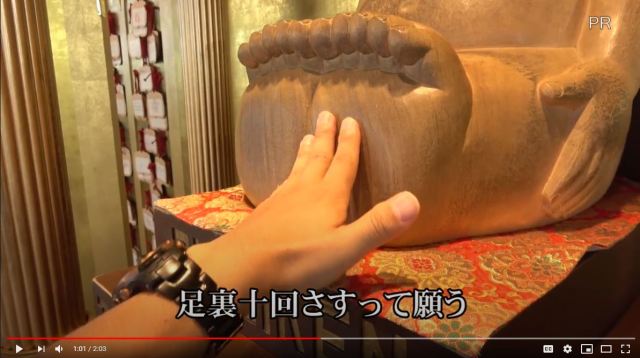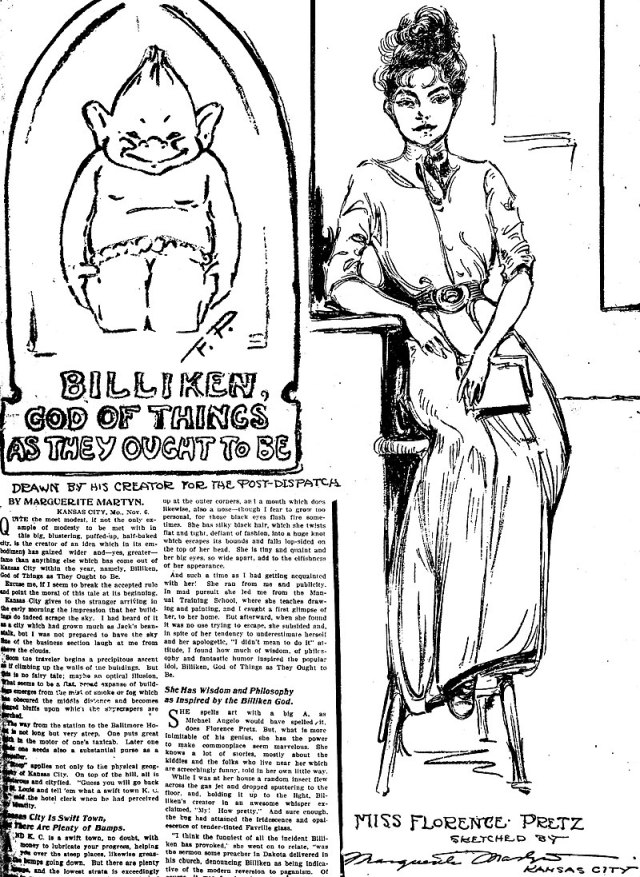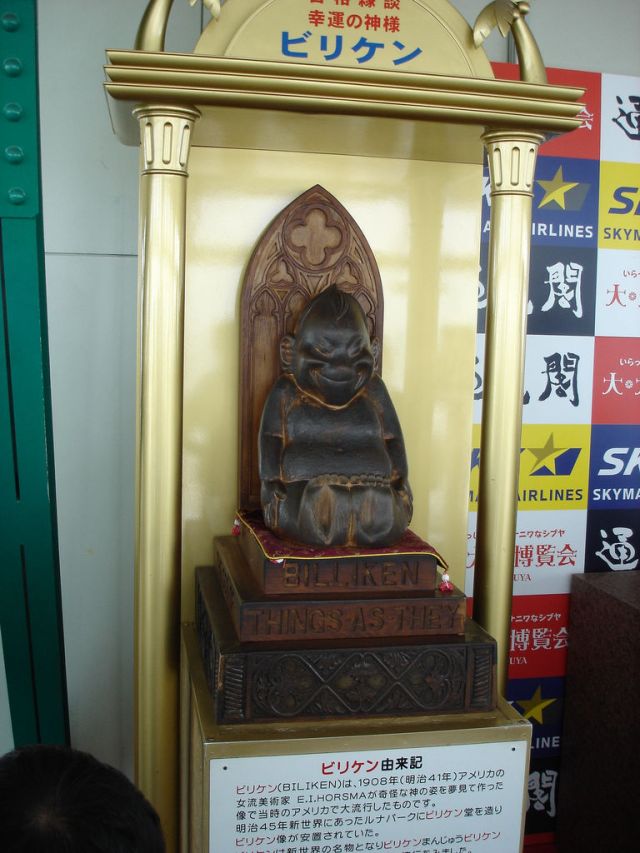
We’re not quite at the Billiken-foot-rubbing stage of normalcy yet.
While still sitting on the possible cusp of second-wave coronavirus outbreaks in Japan, shops and attractions are slowly getting back to business. Far from a full blown reopening, however, tight restrictions are being exercised in several industries such as amusement park guests being asked to refrain from showing emotions and to practice social distancing with the ghosts in haunted houses.
Now, you might be asking: “Well, at least I can still go and rub the large feet of a monkey-like god statue in Osaka, right?”
Wrong! As the following news report shows, visitors to Osaka’s famous Tsutenkaku tower are instructed to instead “air touch” the soles of its famous Billiken statue for the time being.
If you weren’t asking the previous question, then you might now be asking: “What the hell are you talking about?”
It all started back in 1908, when an American artist by the name of Florence Pretz (no relation to the snack) had a vision of this mysterious creature in a dream. After committing its likeness to paper and giving it the name Billiken, Pretz patented her newfound deity as “The God of Things as They Ought to Be.”
Around that same time the Meiji restoration was in full swing in Japan, and the country was rapidly embracing Western culture, partly by scooping up the licenses for iconic western figures left and right. This is about the same time that American Kewpie dolls were imported to Japan, only to ultimately become the face of its leading mayonnaise brand.
For better or for worse, a prime minister of Japan during the Billiken fad, Terauchi Masatake, bore an uncanny resemblance to the magical troll and was even nicknamed “Prime Minister Billiken.”
For much of the early 20th century, Billiken lucky charms were enjoying huge popularity in both America and Japan and in 1912 a famous statue of him was placed in the original Tsutenkaku of Luna Park amusement park in what is now the Shinsekai area of Osaka. A Japanese superstition was also promoted that rubbing Billiken’s large protruding feet will bless you with good luck.
▼ Japan also gave Billiken his own theme song, Billiken Samba, at some point
Meanwhile in the US, Billiken-fever began to subside and most of the country gradually forgot about the character. Usage of his likeness became relegated to a few pockets of American culture, most notably as the mascot for Saint Louis University.
▼ Billiken was the winner of Jimmy Fallon’s 2019 mascot slam dunk contest
In Japan too, Billiken was never quite what it was in the early 1900s, and slowly vanished from most parts of the country. It was only in Osaka and the surrounding area that his legacy lived on, in no small part because of his close connection with the heart of the city’s tourism industry.
A wooden Billiken statue, replicating the one installed in Luna Park from 1912 to 1923, was placed in Tsutenkaku in 1979. It was a big draw and so many people rubbed its feet while visiting that they began to develop grooves measuring about 4 centimeters (1.57 inches) deep.
In 2012, on the 100th anniversary of it’s original installation, a new version was installed and currently sits on the observation deck, while the second-generation Billiken was moved to the lower traffic of the fifth floor. Each one still sits there to this very day, ready to dispense good luck in exchange for foot rubs.
And so, that is why Japan will never be quite back to normal until everyone is able to rub the feet of the SLU mascot at the top of a major Osaka landmark.
We’ll get there someday….
Source: Niconico News, Billiken.jp
Top image: YouTube/T.Eguchi
● Want to hear about SoraNews24’s latest articles as soon as they’re published? Follow us on Facebook and Twitter!




 Beautiful onsen complex opens in downtown Osaka, lets you live onsen dream in heart of the city
Beautiful onsen complex opens in downtown Osaka, lets you live onsen dream in heart of the city Dozens of Pikachus make landfall in Yokohama, begin expanding their territory throughout the city
Dozens of Pikachus make landfall in Yokohama, begin expanding their territory throughout the city Osaka’s giant pufferfish may be saved by neighboring business
Osaka’s giant pufferfish may be saved by neighboring business Terrifying and mysterious missing-person poster found in Tokyo neighborhood
Terrifying and mysterious missing-person poster found in Tokyo neighborhood Hotel in Japan is offering rooms for just 390 yen a night, less than the cost of a bowl of ramen
Hotel in Japan is offering rooms for just 390 yen a night, less than the cost of a bowl of ramen Foreigner’s request for help in Tokyo makes us sad for the state of society
Foreigner’s request for help in Tokyo makes us sad for the state of society Japanese city loses residents’ personal data, which was on paper being transported on a windy day
Japanese city loses residents’ personal data, which was on paper being transported on a windy day Should you add tartar sauce to Japanese curry rice? CoCo Ichi makes diners an unusual offer
Should you add tartar sauce to Japanese curry rice? CoCo Ichi makes diners an unusual offer Seaside scenery, history, and so many desserts on Yokohama’s Akai Kutsu【Japan Loop Buses】
Seaside scenery, history, and so many desserts on Yokohama’s Akai Kutsu【Japan Loop Buses】 Ghibli Park now selling “Grilled Frogs” from food cart in Valley of Witches
Ghibli Park now selling “Grilled Frogs” from food cart in Valley of Witches French Fries Bread in Tokyo’s Shibuya becomes a hit on social media
French Fries Bread in Tokyo’s Shibuya becomes a hit on social media Mt. Koya planning to instate visitor’s tax to cope with huge tourist numbers
Mt. Koya planning to instate visitor’s tax to cope with huge tourist numbers Harajuku Station’s beautiful old wooden building is set to return, with a new complex around it
Harajuku Station’s beautiful old wooden building is set to return, with a new complex around it Suntory x Super Mario collaboration creates a clever way to transform into Mario【Videos】
Suntory x Super Mario collaboration creates a clever way to transform into Mario【Videos】 Tokyo capsule hotel’s low month-long rates are an awesome way to sample life in Japan’s capital
Tokyo capsule hotel’s low month-long rates are an awesome way to sample life in Japan’s capital McDonald’s new Happy Meals offer up cute and practical Sanrio lifestyle goods
McDonald’s new Happy Meals offer up cute and practical Sanrio lifestyle goods Japanese ramen restaurants under pressure from new yen banknotes
Japanese ramen restaurants under pressure from new yen banknotes Studio Ghibli releases new action figures featuring Nausicaä of the Valley of the Wind characters
Studio Ghibli releases new action figures featuring Nausicaä of the Valley of the Wind characters New private rooms on Tokaido Shinkansen change the way we travel from Tokyo to Kyoto
New private rooms on Tokaido Shinkansen change the way we travel from Tokyo to Kyoto Red light district sushi restaurant in Tokyo shows us just how wrong we were about it
Red light district sushi restaurant in Tokyo shows us just how wrong we were about it Tokyo Tsukiji fish market site to be redeveloped with 50,000-seat stadium, hotel, shopping center
Tokyo Tsukiji fish market site to be redeveloped with 50,000-seat stadium, hotel, shopping center All-you-can-drink Starbucks and amazing views part of Tokyo’s new 170 meter-high sky lounge
All-you-can-drink Starbucks and amazing views part of Tokyo’s new 170 meter-high sky lounge Beautiful Ghibli sealing wax kits let you create accessories and elegant letter decorations【Pics】
Beautiful Ghibli sealing wax kits let you create accessories and elegant letter decorations【Pics】 Studio Ghibli releases Kiki’s Delivery Service chocolate cake pouches in Japan
Studio Ghibli releases Kiki’s Delivery Service chocolate cake pouches in Japan New definition of “Japanese whiskey” goes into effect to prevent fakes from fooling overseas buyers
New definition of “Japanese whiskey” goes into effect to prevent fakes from fooling overseas buyers Our Japanese reporter visits Costco in the U.S., finds super American and very Japanese things
Our Japanese reporter visits Costco in the U.S., finds super American and very Japanese things Studio Ghibli unveils Mother’s Day gift set that captures the love in My Neighbour Totoro
Studio Ghibli unveils Mother’s Day gift set that captures the love in My Neighbour Totoro More foreign tourists than ever before in history visited Japan last month
More foreign tourists than ever before in history visited Japan last month New Pokémon cakes let you eat your way through Pikachu and all the Eevee evolutions
New Pokémon cakes let you eat your way through Pikachu and all the Eevee evolutions Sales of Japan’s most convenient train ticket/shopping payment cards suspended indefinitely
Sales of Japan’s most convenient train ticket/shopping payment cards suspended indefinitely Sold-out Studio Ghibli desktop humidifiers are back so Totoro can help you through the dry season
Sold-out Studio Ghibli desktop humidifiers are back so Totoro can help you through the dry season Japanese government to make first change to romanization spelling rules since the 1950s
Japanese government to make first change to romanization spelling rules since the 1950s Ghibli founders Toshio Suzuki and Hayao Miyazaki contribute to Japanese whisky Totoro label design
Ghibli founders Toshio Suzuki and Hayao Miyazaki contribute to Japanese whisky Totoro label design Doraemon found buried at sea as scene from 1993 anime becomes real life【Photos】
Doraemon found buried at sea as scene from 1993 anime becomes real life【Photos】 Tokyo’s most famous Starbucks is closed
Tokyo’s most famous Starbucks is closed One Piece characters’ nationalities revealed, but fans have mixed opinions
One Piece characters’ nationalities revealed, but fans have mixed opinions We asked a Uniqlo employee what four things we should buy and their suggestions didn’t disappoint
We asked a Uniqlo employee what four things we should buy and their suggestions didn’t disappoint Princesses, fruits, and blacksmiths: Study reveals the 30 most unusual family names in Japan
Princesses, fruits, and blacksmiths: Study reveals the 30 most unusual family names in Japan Forget geisha and samurai, experience Japan by dressing up as an Osaka Obachan
Forget geisha and samurai, experience Japan by dressing up as an Osaka Obachan New Adidas Hachiko sneakers pay homage to Shibuya’s famous loyal dog
New Adidas Hachiko sneakers pay homage to Shibuya’s famous loyal dog Newly unveiled “horror room” in Osaka apartment promises a creepy day or night’s stay
Newly unveiled “horror room” in Osaka apartment promises a creepy day or night’s stay Osaka ends sister city relationship with San Francisco over comfort women memorial dispute
Osaka ends sister city relationship with San Francisco over comfort women memorial dispute This little-known temple in rural Japan has a giant Buddha bigger than Kamakura’s or Nara’s【Pics】
This little-known temple in rural Japan has a giant Buddha bigger than Kamakura’s or Nara’s【Pics】 Quiz of the Week: Round 6 (Now made with the tears of sad children*)
Quiz of the Week: Round 6 (Now made with the tears of sad children*) Yokosuka’s Statue of Liberty gives the word liberty a whole new meaning
Yokosuka’s Statue of Liberty gives the word liberty a whole new meaning Sailor Moon Jimmy Choo collaboration adds Luna, Tuxedo Mask kiss, and Inner Senshi bags【Photos】
Sailor Moon Jimmy Choo collaboration adds Luna, Tuxedo Mask kiss, and Inner Senshi bags【Photos】 252 Pocky lovers gather in Shibuya to set a world record 【Video】
252 Pocky lovers gather in Shibuya to set a world record 【Video】 Tekken video game series shows off its first fighter from the Philippines: Josie Rizal 【Video】
Tekken video game series shows off its first fighter from the Philippines: Josie Rizal 【Video】 Line of Japanese-smelling watches sold through Japan Post Office
Line of Japanese-smelling watches sold through Japan Post Office Enormous Buddhist Kannon statue in Sendai shocks visitors with otherworldly looming
Enormous Buddhist Kannon statue in Sendai shocks visitors with otherworldly looming Conan O’Brien lays out his case that anime’s Detective Conan is just a copy of him【Video】
Conan O’Brien lays out his case that anime’s Detective Conan is just a copy of him【Video】 Cute sisters in Japan take a snowy spill perfectly in-sync with each other【Video】
Cute sisters in Japan take a snowy spill perfectly in-sync with each other【Video】 Pop quiz: Test yourself in 5 situations of Japanese manners and customs
Pop quiz: Test yourself in 5 situations of Japanese manners and customs
Leave a Reply